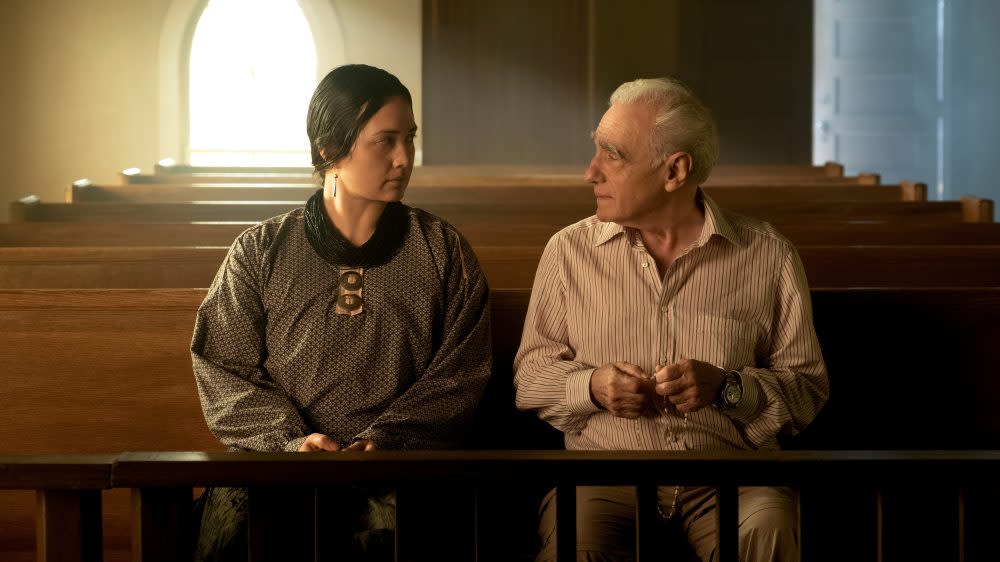‘Killers of the Flower Moon’: Lily Gladstone’s Devastating Scream Scene Came Together in 15 Minutes

- Oops!Something went wrong.Please try again later.
- Oops!Something went wrong.Please try again later.
- Oops!Something went wrong.Please try again later.
SPOILER ALERT: This story contains spoilers for “Killers of the Flower Moon.”
The haunting “Killers of the Flower Moon” scene where Lily Gladstone’s Mollie Burkhart sits at the bottom of a staircase and lets out a devastating scream after learning that her sister was killed in an explosion is one of the film’s most affecting moments. According to cinematographer Rodrigo Prieto, it was unscripted.
More from Variety
Prieto, a longtime collaborator of director Martin Scorsese, believes the last-minute change came together because the filmmaker “trusts his actors, and they’re a part of the process.”
Based on the nonfiction book by David Grann, “Killers of the Flower Moon” stars Leonardo DiCaprio as Ernest Burkhart, a war veteran who comes to Oklahoma in the 1920s to work for his wealthy uncle, William King Hale, played by Robert De Niro. Hale encourages Ernest to marry Mollie, as her Osage family owns oil rights and could make them rich. Throughout the film, the members of Mollie’s family are murdered one by one, making it easier for Hale and Ernest to seize the headrights.
When a bomb destroys her house in the middle of the night, Mollie’s sister Reta and her family are killed instantly. Ernest sees the house destroyed and tells Mollie the news. But the scene wasn’t meant to play out that way.
Speaking at Variety’s Artisans Screening series, Prieto said, “The shot that Scorsese had designed had his point of view coming into the house through the doorway and the living room. The family, maid and kids were waiting for the news. That was the shot I had prepared.”
That preparation was completely redesigned after Scorsese got Gladstone’s input. The director asked the actor where would she be at that moment when she learned another member of her family had been murdered, to which Gladstone replied, “I’d be in the cellar.” On the day of the shoot, Prieto had to check that the house constructed by production designer Jack Fisk even had a cellar. Luckily, it did.
Said Prieto, “I had to light it and make a shot in 15 minutes that would work. That’s the shot you see in the movie. It’s the same POV that he had designed. But now, the camera actually goes through the living room, through a little hallway into this door. And there we see the stairs to the cellar.” He continued, “Even the sound of the child crying, that’s a real sound because the child was not happy. It becomes a haunting moment, even visually. Her scream is just tremendous.”
Set decorator Adam Willis added that he was dressing another set when he got the call about the change: “I had to run back over, and we had to quickly dress the set.”
Willis and Prieto were joined by costume designer Jacqueline West, Indigenous casting director Rene Haynes and visual effects supervisor Pablo Helman for the conversation, which was moderated by senior artisans editor Jazz Tangcay.
While “Flower Moon” doesn’t appear to be VFX heavy, Helman needed to deliver 700 shots. Many of these were invisible effects, a directive given by Scorsese. Helman digitally added in cows, extended sets and worked on the oil rigs, which were all part of that “invisible process.”
Scorsese made it clear he wanted everything to be as authentic and as accurate as possible. For costume designer West, that meant working with Osage Nation consultant Julie O’Keefe and researching Osage attire. “They were unique in how they wore their clothes, and what they wore. They were pulling a lot of trade items like calicos, wools, ribbons, satin, beads and silver metal,” West said. “The more I dove in, the more absolutely captivated I was by how different they were than the other Nations that also inhabited the plains.”
Willis pored over historical archives in Kansas, Arkansas, Missouri, Texas and the surrounding states of Oklahoma. He said, “I ended up coming up with probably about 4,000 photos.” That would become his bible, where he could zoom in on the detail of what was on desks and see how lights were wired into the ceiling. “There weren’t any outlets in the walls, so a lot of the lamps back then would have an Edison socket as its plug. So you would plug it into the ceiling into your light fixture. That was your only access point of electricity,” Willis said. “In a couple of scenes in the film, you’ll see a cord going straight up and being plugged into the chandelier.”
Haynes discussed the grand task of Indigenous casting. Working alongside casting director Ellen Lewis, they put out an open casting call for the Indigenous community. They saw over 2,500 individuals, putting all of the auditions on reels. The casting process took place in November 2019, before the world shut down due to the pandemic. “The beauty of this, and the advantage, was a few months later we could never have done that,” Haynes said.
Watch a video of the panel above.
Best of Variety
Sign up for Variety’s Newsletter. For the latest news, follow us on Facebook, Twitter, and Instagram.

